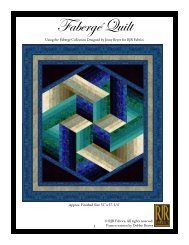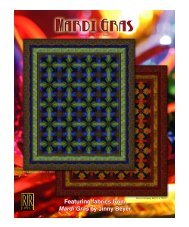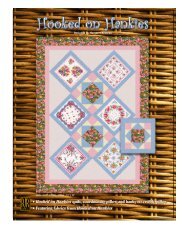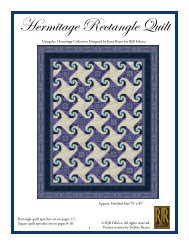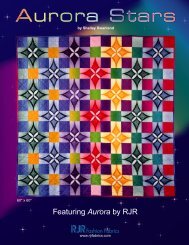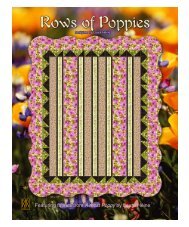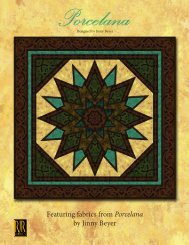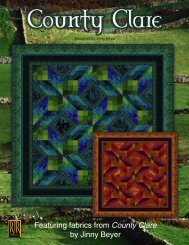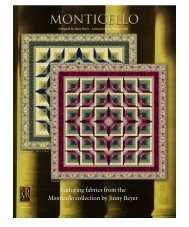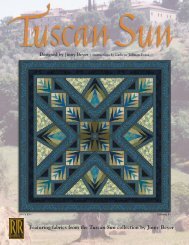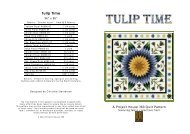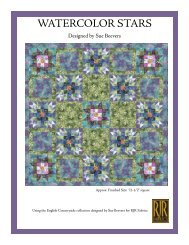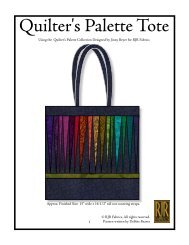You also want an ePaper? Increase the reach of your titles
YUMPU automatically turns print PDFs into web optimized ePapers that Google loves.
Dr. Clarke, though not a quilter, is an accomplished needleworker in her own<br />
right. Before she donated the collection, Dr. Clarke prepared cross-stitched<br />
quilt labels in colors complimenting the fabrics and detailing the maker, dates<br />
and history of the quilt. <strong>The</strong>se labels were stitched to the back of each quilt,<br />
forever linking them to their history.<br />
Much of this information was extracted from the writings of Lynne Swanson and Mary Worrall<br />
of the MSU Museum.<br />
“From its inception, quilting has taken place within families. Fellowship between<br />
mothers, daughters, and extended family transpire as women gather to stitch quilts,<br />
while strengthening family bonds... Families cherish their quilts as physical and<br />
emotional ties to their past. MSU Museum is proud to ensure the safekeeping of many<br />
collections of family quilts so they can be treasured by future generations.”<br />
— Lynne Swanson on the Clarke Family Quilt Collection<br />
QUILTING IN THE 1930S<br />
<strong>The</strong> Clarke Family quilt collection offers a unique glimpse into the quilting<br />
lives of a Detroit family. <strong>The</strong> quilts and supporting materials reflect the entire<br />
quilt making process from inception to completion as well as the entire output<br />
of quilts by one family over a 20-year-period. Additionally, the collection<br />
reflects regional and national trends in quilt making during the Great<br />
Depression, when there was a rejuvenation of interest in quilt making and<br />
home arts, often referred to as the Renaissance of American Quilting. In the<br />
1930s, Detroit and other cities across the US burgeoned with quilting<br />
activities, including groups, shows and newspaper columns devoted to<br />
domestic arts.<br />
With the resurgence of interest in quilting, many new pattern and fabric<br />
companies came into being to take advantage of the new market of consumers<br />
eager to join the fad of producing and decorating their homes with quilts.<br />
Commercial quilting patterns were circulated in newspapers and in mail order<br />
catalogs, since shopping by mail order was increasingly popular among<br />
women. Companies hired quilt designers to produce patterns and fabrics that<br />
would add a "modern" look to the traditional craft.<br />
<strong>The</strong> resulting quilt patterns were based loosely on traditional quilt designs.<br />
1930s quilt designers such as Marie Webster and Anne Orr favored floral<br />
appliqué designs that were adapted from the elaborate floral medallion quilts<br />
of the Victorian era. Though the patterns were often based on traditional 19th<br />
century quilt designs, there is a distinct shift in the look of quilts from this<br />
period. <strong>The</strong> 1930s brought hard times for most Americans, but 30s quilts<br />
were bright and cheerful. Designers chose to use a new palette of clear, solid,<br />
pastel colors, such as buttery yellow, “thirties green,” pink, lavender, light<br />
blue and tan. Novelty prints and lively calicoes, made available through<br />
advances in the textile industry, were the new fad in fabric. <strong>The</strong><br />
commercialization and mass merchandising of quilt patterns and fabric lead<br />
to quilts that were both homogeneous in style and palette.<br />
To encourage and foster quilt making, companies introduced new timesaving<br />
products. Quilters no longer had to trace pattern pieces and mark lines<br />
for cutting and sewing. Similar to a garment pattern, the new commercial quilt<br />
patterns came in a large envelope with actual size patterns printed on a large<br />
sheet of paper, which could then be traced to create templates. <strong>The</strong> pattern<br />
envelope also included instructions to make the quilt top, as well as<br />
suggestions on color and finishing. For women who were willing to pay a<br />
little extra, quilt kits could be purchased with the pattern pieces already<br />
stamped on a bleached cotton sheet, commonly referred to as the “paint-bynumber<br />
quilting technique.” <strong>The</strong> quilter merely had to cut out the appliqué<br />
and apply it to its stamped location on the sheet. *<br />
Quilt patterns were often purchased or copied out of newspapers and<br />
magazines. If a pattern was bought, it was usually shared with friends. Of the<br />
thousands of commercial quilt patterns distributed across the country, a few<br />
of the patterns were so popular among the quilting public that they soon<br />
became recognized as classic quilt designs, such as Dresden Plate,<br />
Grandmother’s Flower Garden, Double Wedding Ring and Sunbonnet Sue.*<br />
<strong>The</strong> Clarke collection is a textbook example of these “Depression Era” style<br />
quilts. Quilt patterns found in the scrapbooks of the Clarke family included<br />
those designed and marketed by Anne Orr, McCall’s Pattern Company,<br />
Mountain Mist Batting Company, and those published by the Detroit News<br />
and the Detroit Free Press.<br />
In the 1920s, people became fascinated with the “Colonial Times” and<br />
attempted to recreate them or at least pay homage to them through quilts.<br />
However, 20s quilts were more than just a warm blanket. <strong>The</strong>y became a<br />
decorative piece for the home reflecting the prosperous times of the decade.<br />
<strong>The</strong> fabrics were pretty, and the women had the money to buy them. But<br />
when the times got harder in the 30s, these pastel, decorative fabrics<br />
continued to be promoted in magazines, and there was again very much a<br />
purpose to quilting.<br />
In the 30s, women were forced to fall back on their pre-industrial domestic<br />
skills of sewing and knitting by hand, since sewing machines were harder to<br />
afford. Quilting called on these domestic skills while serving a functional<br />
purpose of using scraps of fabric to create blankets for warmth. Many of the<br />
quilts by Bozena Clarke were made collaboratively, using scraps of fabric<br />
saved from the tailoring of the family's clothing. During the Depression,<br />
Bozena used every scrap of fabric she could salvage in her quilts.<br />
*Soft Covers for Hard Times by Merikay Waldvogel pg. 11-16.<br />
Much of this information was extracted from the writings of Marsha MacDowell, curator of the<br />
MSU Museum.



